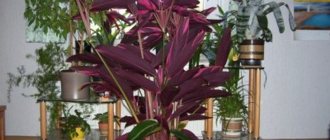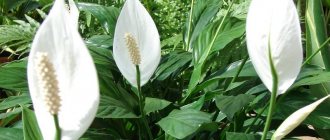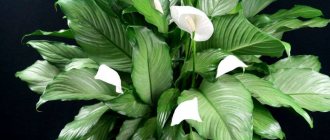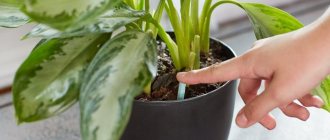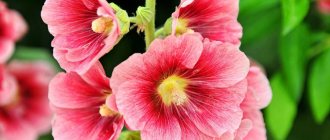Lychnis is a perennial decorative flowering shrub, popularly nicknamed “Adonis” for its bright, rich color. According to another version, the name refers to one of the varieties, the stems of which in ancient times were used as a wick for lamps and icon lamps. The second unofficial name is “soap plant,” given to it for the ability of the petals to become soapy when rubbed with your hands. It has been cultivated since the 16th century; currently, Lychnis is grown in the open ground of garden plots throughout almost the entire territory of Russia. It has many decorative varieties and hydrides.
General description with photo
Lychnis is a shrubby perennial plant from the Clove family, up to 1 m high. The round, erect stem has short pubescence, an unusual ash-gray hue and a very small number of semi-stem-embracing elongated leaves with a heart-shaped base. The leaf blades are rough on both sides. The flowering is bisexual, the inflorescences are spherical or corymbose, collected from many small, up to 2 cm, buds, colored from white or light yellow to bright orange or deep red. Some species produce single buds and do not form inflorescences. By the beginning of autumn, the multi-nut fruit ripens, filled with dark small kidney-shaped seeds that retain their viability for no more than 3-4 years.
Lychnis crown - description of the variety
Lychnis has felted oblong-lanceolate and oval leaves of a silver-gray hue, curved shoots, blooms with crimson buds.
Lat. Lychnis coronaria (photo)
The flower was bred in southern Europe. As a result of breeding work, varieties with white and pink flowers were obtained.
A low bush of a perennial plant reaches a height of 40 cm to 80 cm. Flowering begins in June and continues until late autumn, although with the onset of cold weather the flowering is sparse.
During the growing season, the lush bush manages to grow many spreading shoots, which is why it appears delicate.
Varieties and varieties of Lychnis with photos
Information about the species diversity of this plant is very contradictory; from 2 to 5 dozen varieties are named. Of these, only 15 species are grown in horticulture, suitable for cultivation in open ground conditions of a temperate climate zone.
This perennial can grow in one place for about 5 years.
Lychnis Chalcedonian
Produces an erect, meter-tall stem with short, hard pubescence. The leaves are sparse, located mainly in the lower part. The inflorescence is spherical, consists of many small red flowers (in the basic version).
Lychnis crown
The highly branched stems are silver in color and can also grow to a height of 1 m. A characteristic feature of the species is single flowering - the flowers are not collected in inflorescences and are larger in size. The species is valued for its long flowering, which lasts almost the entire summer. This variety is the most shade-tolerant.
Lychnis alpine
A low-growing representative of the culture, rising only 20 cm from the ground, with excellent decorative qualities. The most popular variety of the variety is “Lara”, which blooms buds in a delicate pink color. When growing this variety in open ground, you need to pay special attention to the acidity of the soil. Like all representatives of the variety, he cannot tolerate its inflated indicators.
Lychnis Viscaria
Tall species with dark purple shoots. It differs from other varieties in the appearance of the inflorescences, which have a paniculate shape and double buds, painted in white, soft pink or crimson tones. Flowering continues throughout the first 2 months of summer.
Lychnis Haage
Forms a medium-sized bush and is a varietal garden hybrid. The inflorescence is racemose, neat, orange or bright red in color. The best representative of the species is the “Scorched Lava” variety with the fiery color of the petals.
Lychnis of Jupiter
The variety is represented by a highly branched, loose bush with silvery-ashy, short pubescent shoots and single flowers of raspberry-purple color.
Description
Lychnis crown is a herbaceous bush, the height of which reaches 40-90 cm. A rosette of leaves is concentrated near the ground, and shoots with peduncles are directed upward. You can see the incredibly beautiful blooms in June. At the same time, the number of inflorescences on the bush is huge. Some flowers bloom in autumn and make the bush beautiful until autumn.
Khnis crowned
The herbaceous bush has an openwork appearance. During the summer period, it manages to grow a large number of branched shoots. Its leaves are presented in a gray shade with a silver coating. In the basal rosette the foliage is oblong-lanceolate, and on the shoots it is oval.
Even autumn frosts will not spoil the appearance of crown lychnis. On the ashen background of the foliage you can see small lights-flowers. This type of decorative culture combines style, grace and restraint. The plant looks great when planted alone in a flower bed or in combination with other flowers. You can learn how to plant and care for the Lychnis flower in this video.
In the video - Lychnis crown in the garden:
Planting and care
Lychnis does not make high demands on growing conditions, but they still exist. His agricultural technology provides the following care points and conditions for planting in open ground.
Illumination
The culture can easily tolerate partial shading, but the abundance and brightness of flowering will be directly dependent on the sunlight it receives.
Soil requirements
The main requirement of Lychnis for soil, especially some of its varieties, is its acidity. The plant does not tolerate too acidic soils. The situation with high pH can be corrected by adding lime fluff. The second important condition is that the soil must be well drained and light enough. In places of low relief, where melt, rain and irrigation waters stagnate, Lychnis will look depressed and may even die.
Watering mode
The plant loves regular moderate watering without stagnant water. If lychnis is planted on heavy clay soil, it will have to be watered in small portions to avoid prolonged high humidity. In the absence of regular rain, it is enough to moisten the soil once or twice a week.
It is recommended to water lychnis in the morning, since it tends to actively absorb moisture only during sunny hours. Evening watering can lead to useless and even harmful soaking of the roots.
Top dressing
The first application of fertilizers is made at the stage of planting in open ground. The area is dug up with the addition of 50 g of potassium magnesia (potassium-magnesium sulfate) and the same amount of granulated superphosphate per 1 sq.m. to the soil. The next feeding is done before budding begins, adding 1 tbsp to the water for irrigation. into a bucket of potassium sulfate and urea. If superphosphate was not added during planting, then the same amount of this product should be added. If desired, you can feed the bushes one or two more times, using any mineral complexes, for example, the plant responds well to the application of the drug "Agricola 7".
Lychnis care after flowering, pruning
The plant does not require formative pruning, but to preserve its decorative effect, it is necessary to immediately tear off all wilted buds, this will additionally stimulate the formation of new ones. In preparation for the winter season, the entire above-ground part of the plant is completely removed (without roots). It is not recommended to break off the stems to avoid damage to the root system; it is better to cut them off with garden pruners. The crop has high frost resistance, so basic varieties and simple varieties will not need any shelter in winter. But this does not apply to terry garden hybrids, which do not have high natural survival rate in extremely cold winters. After pruning, they must be covered with a thick layer of mulch, for which peat, dry fallen leaves or sawdust are well suited. You can simply heap a high layer of dry soil over the wintering site of the roots.
Lychnis care
Growing conditions
Lychnis in open ground needs regular watering, especially in extreme heat. After moistening, you need to periodically loosen the soil around the plants and pull out the weeds. Keep in mind that Lychnis is a plant without assertiveness, and you will have to fight for its life and health. Remove spent blooms to prolong the flowering of lychnis, and do not allow other plants to creep into its area.
Growing lychnis involves applying 2-3 fertilizers during the growing season. The first fertilizing with complex mineral fertilizer is carried out as soon as the seedlings grow a little and become stronger, and subsequent fertilizing is done every 2-3 weeks.
Diseases and pests
If watered too frequently or excessively, Lychnis may develop root rot, rust, or leaf spot. For prevention purposes, you need to set up a plant watering regime taking into account your climate and weather so that water does not stagnate in the roots of the lychnis, and if fungal diseases are detected, without hesitation, resort to treating the lychnis with a fungicide solution.
- How to care for daylilies in a flower bed
If you notice aphids or leaf rollers on the plants, treat the planting with a decoction of tobacco or tomato tops, adding grated soap, but if there are a lot of insects, resort to insecticides.
Lychnis after flowering
Lychnis overwinters in the garden without shelter; for this it is quite frost-resistant. The only exceptions are terry varieties of plants, which must be covered for the winter. When the leaves and stems of Lychnis begin to turn yellow and wither, they are cut to the ground. After pruning, terry plants are covered with peat, leaves or covered with dry soil.
As you can see, planting and caring for Lychnis is not labor intensive.
Growing Lychnis from Seeds
One way to propagate a plant is by sowing seeds. Planting material remains viable for at least 3 years, so you can plant lychnis seeds both before winter and in spring, when the snow melts. Pre-winter sowing is more desirable, since in this case they will benefit from natural stratification in the cold soil. At home, stratification for a month is also a mandatory procedure for lychnis. The second advantage of winter growing from seeds is earlier flowering - in this case it can occur as early as the summer of next year, although not in full force. A more troublesome method can speed up the process - sowing seeds using the seedling method, which will also allow you to get flowering already in the current season.
Before transplanting seedlings into open ground, they must be gradually hardened in air for 2 weeks, first during the day and then at night. You can sow seeds directly into open ground from April to June; later planting will not produce healthy plants.
The time period for the emergence of Lychnis seeds is 20-25 days, but they can vary depending on temperature conditions.
Planting scheme
When transferring seedlings to open ground, it is necessary to leave 25-30 cm between the seedlings; this will give a dense flower bed without bald spots, but will eliminate its thickening, which can provoke fungal diseases.
Flower propagation
Beautiful dawn, like Lychnis chancedonii, reproduces by seeds : self-sowing or seedlings, as well as by dividing the bush. When seeds germinate from self-sowing, the seedlings are thinned out, leaving the strongest and strongest sprouts. Care as usual: water, feed and remove weeds.
When propagating by seedlings, the seeds are sown in early March in special boxes with fertile soil, covered with film and left in a warm, well-lit room for germination. The film is lifted daily to remove condensation and ventilation, and with the appearance of the first shoots it is completely removed. Further, care consists of watering and lighting, and with growth of 3-4 cm, weeding is carried out, removing weak and sluggish shoots. When the growth of the shoot reaches 7 cm, the seedlings are planted in separate pots or cups. With the onset of warmth, the sprouts are planted in open ground.
In case of dense thickets, you can carry out “cleaning”. Dig up several plants with roots and divide them and plant them in a new place.
Reproduction by dividing the bush
The method is simple and quick in terms of obtaining results, but only lychnis bushes that are at least 5 years old are suitable for it, i.e. those that, due to age, are already losing their decorative effect and need to be updated. In October or early spring, the bush is dug up with maximum coverage of the root system, carefully cleared of the main soil and divided into several parts. The number of divisions is determined based on the development of the rhizome. Each of them must retain its viable part and at least one growth point. The resulting bushes are planted immediately in a permanent place, maintaining the above distance. Abundant watering is carried out.
If the bush was transplanted in the spring, it is necessary to ensure that in the first days after this the seedlings are shaded from the too active spring sun.
Care
It can be grown in any moderately fertile area that is located in a sunny place or with partial light. More leaves appear in the shade, but fewer flowers. It does not tolerate heavy soil and prolonged summer rains, which can lead to rotting.
In early spring, it is necessary to feed with rotten compost around the main plant, and on the eve of flowering, it is advisable to feed with organic fertilizer containing nitrogen. Lychnis is so optimal that it fertilizes itself with its own fallen and rotted leaves over the winter.
If you systematically remove faded inflorescences, the flowering period can be significantly extended. When preparing for winter, the entire above-ground part must be cut off and covered with a little soil on top. The plant is frost-resistant, so there is no need for shelter.
Propagation by cuttings
This method of propagating Lychnis is most preferable for terry varietal hybrids. The seed method is acceptable for them only if you purchase ready-made seeds from the manufacturer, since seeds collected at home will not be able to obtain the same decorative qualities. As for dividing the bush, only well-developed, middle-aged plants are suitable for it. Cuttings are cut in June. Due to the rare location of the stem buds, their length should be at least 20-25 cm in order to guarantee that they capture the growing points. Rooting occurs according to the traditional pattern in a box or on a training bed with nutritious loose soil under a plastic or glass cap. Transplantation to a permanent place can be carried out in early autumn, so that by winter the cuttings have time to acclimatize and take root well. In the first winter it is better to cover them.
How to care for a plant
In order for Lychnis crown to bloom profusely and delight with its beauty for a long time, it is necessary to follow several rules of care.
Selecting a location
The culture in question feels great in a sunny area. There it will bloom until frost. If you plant Lychnis in partial shade, it will spoil the decorative appearance of the plant.
It produces many leaves and few buds. But even such a bush will attract attention. The plant can be planted in open areas, as it is not afraid of strong winds and rain.
Soil and fertilizing
Lychnis crown produces abundant flowering in poorer soil. If there is a lot of organic fertilizer, the bush begins to grow fat and bloom worse. The flowering period is also shortened. It is necessary to place sand, not humus, in garden soil. At the same time, it is worth choosing fertilizers that do not contain nitrogen.
It is necessary to irrigate the soil moderately. If there is excess dampness there, this will become a reason for the development of fungal infections. If the weather is not hot, then watering will be done once a week. But this information will help you figure out how to use a water sprinkler for irrigation.
Preparing for winter
In order for the plant to withstand frost, it is necessary to cut off its above-ground part. But there is absolutely no need to cover the plant with anything. As soon as the first snow melts, new shoots, leaves and buds will begin to form.
Diseases and pests
The main lovers of Lychnis among insect pests are the moth, leaf roller and the ubiquitous aphid. You can fight minor lesions with folk remedies - tobacco, garlic and soap solutions. In case of advanced attacks, chemical agents cannot be avoided. In the event of an aphid invasion, it is necessary to take control measures against their main distributors - ants.
Lychnis diseases are almost always the result of improper care, in most cases - dense planting or waterlogged soil. It is necessary to establish the cause and eliminate it. Plants affected by putrefactive processes will have to be removed from the site and burned.
Pests and diseases
Adonis is susceptible to attacks by certain insect pests:
- spider mite;
- aphid;
- leaf roller.
At the initial stage of infection, Lychnis crown can be treated with a soap solution. Subsequently, acaricides and insecticides should be used.
Common diseases of adonis are root rot, rust, spotting. Fungicides are used for prevention and treatment. In case of serious damage, diseased specimens are destroyed to save the rest.
Lychnis in landscape design
Lychnis chalcedony red in landscape design photo
The use of brightly flowering lychnis in landscape design is widespread. It looks great in solo and group plantings and will become a remarkable accent in a lawn, flower bed, flower garden, or mixed border.
Plant low-growing ones on alpine hills, in rock gardens, rocky gardens, and use them to frame borders and garden paths.
Lychnis in garden design photo
Higher ones can be used to decorate the walls of outbuildings, gazebos, and fences. Here the partner will be a handsome clematis.
Lychnis cuckoo flower is moisture-loving - frame the banks of artificial reservoirs, you can plant it in a shaded place.
Arkwright's Lychnis in garden design Lychnis arkwrightii 'Vesuvius photo
Suitable neighbors of lychnis: bells, asters, gypsophila, cornflower, salvia, large-bush carnations, primroses, daylilies, gaillardia.
It’s a great idea to create a whole flowerbed of lychnis “light bulbs”, combining different shapes and colors.
You can plant Lychnis in a pot to decorate a balcony, gazebo, or veranda.
The use of lychnis in landscape design
Due to its unusual beauty, the dawn is very popular among gardeners. It is often used to frame flower beds, paths and even decorative beds. Bright bushes look original as a solo object. Against the background of a green lawn, they become bright, juicy spots.
In the alpine hill, the lychnis variety of the same name, alpine, takes pride of place. It goes perfectly with stones from an aesthetic and agricultural point of view. The garden planting is moisture-loving, so it will become a colorful decoration of the coastline of artificial and natural reservoirs. By combining several varieties with different colors, gardeners create “burning” garlands that are beautifully reflected in the water surface. Such decor in the garden will not go unnoticed. This colorful representative of the flora is irreplaceable in a mixborder. It will become a worthy “neighbor” for almost any culture.
Garlands of inflorescences of various shades will certainly decorate the area, thanks to the rather long flowering - for a long time. This very unpretentious and quite popular plant will add bright colors to any flower arrangement in the garden.
Features and description of Lychnis
Lychnis is a perennial herbaceous plant that belongs to the large Clove family. Very often, the Lychnis flower is confused with representatives of the Smolevka family and is included in this group. The distribution area of this unusual plant is quite wide. It can be found throughout the Northern Hemisphere; its habitat extends to temperate, northern and arctic climates. The homeland of this bright flower is considered to be the territory of Western Russia, part of Siberia, Central Asia and Mangolia. Sometimes in nature you can find annual species of Lychnis, although in gardening preference is still given to perennials.
The name of the plant itself comes from the Greek word “lychnos”, which in translation means lamp, lamp, torch. This is due to several reasons. Firstly, the meaning of the name of the flower is associated with the bright colors, which are always the first to catch the eye. It is red, pink, lilac colors that can be seen from a great distance. Secondly, in ancient times this plant was used as a wick for oil lamps and lamps.
Lychnis is popularly known under different names, which are more familiar to people. In Russia, this plant is called zorka or adonis for all the same bright colors. Sometimes on the Internet you can find the name “Tatar soap” or “soap plant”, which are associated with the ability of some plant species to lather. The roots and stems, for example, of Zorka white were often used during washing in the past.
Description of Lychnis:
- In most cases, the Lychnis plant is a perennial plant that resembles a small bush in its shape.
- The root system of Lychnis is represented by a rather powerful rhizome, which ensures good survival rate.
- Depending on the specific species and variety, the stems of the plant may be different. They reach an average height of 20 cm to 100 cm.
- The stems are erect, in one case slightly pubescent, and in the other rough.
- On one bush, the stems can be single, or they can be collected in a group.
- Along the entire length of the erect stems of Lychnis, oblong lanceolate leaves of dark green or light green color grow. However, sometimes you can find species of Lychnis with burgundy foliage.
- Bright lychnis flowers bloom on the top of the stems. Less often they are single, most often small flowers are collected in corymbose or capitate inflorescences, consisting of 20-50 pieces.
- Flowers on one plant can be bisexual.
- Lychnis flowers are also very unusual in their structure. They consist of two lobes, different in depth and size.
- Flowers can be of various shades: white, yellow, red, pink, lilac.
- Flowering usually begins in early summer and lasts from 1 to 2 months.
- In autumn, in place of faded flowers, seed pods appear, shaped like pentagons. Lychnis seeds are dark brown in color and small in size.
- In total, there are currently just over 35 varieties of Lychnis, the cultivation of which is very simple and does not require a lot of knowledge.
Lychnis planting technology
- We talked about sowing seeds a little higher; now we will focus on planting lychnis after division and when purchasing seedlings of this plant in the store.
- When planting on a prepared plot of land that has been cultivated for another month, it is necessary to make planting holes suitable for Lychnis seedlings. Their size is determined depending on the size of the rhizome. If you are planting several Lychnis plants, maintain the optimal distance between them - approximately 20-25 cm.
- Since these plants prefer to grow in well-drained soil, add coarse, clean sand or fine gravel to the bottom of each hole.
- If you purchased seedlings, carefully remove them from the container and check the roots. There is no need to shake off the soil.
- Carefully place the plant in the hole and cover it with soil, compacting it lightly with your hands.
- After planting the seedlings and lychnis seedlings, you need to water them abundantly and loosen the soil around them.
Description of the plant
Lychnis is a herbaceous rhizomatous plant of the Clove family, cultivated as a perennial. The flower is popularly known as “dawn”; the name of the culture comes from the Greek word for “lamp”. In its natural environment it is found in Mediterranean countries and some regions of Asia.
The height of the branched bush varies from 40 to 100 cm. The stem is thin, has pronounced pubescence in the form of hairs. The lanceolate leaves are dark green, the surface of the blade is rough. Flowering is possible from the beginning of summer; with quality care it continues until autumn. The flowers are tubular in shape with wide open petals. They can be painted in a wide variety of shades, with red, purple and white shades being popular varieties. During flowering, Lychnis emits a faint but pleasant aroma. The fruit is a small nut with many seeds. They remain viable for up to 4 years.
Lychnis, photo
Lychnis is a very beautiful and amazing plant, which from the first moments of admiring it enchants with its simplicity and at the same time brightness. Having planted this plant on your site, you will admire the colorful and fragrant inflorescences for a long time.



